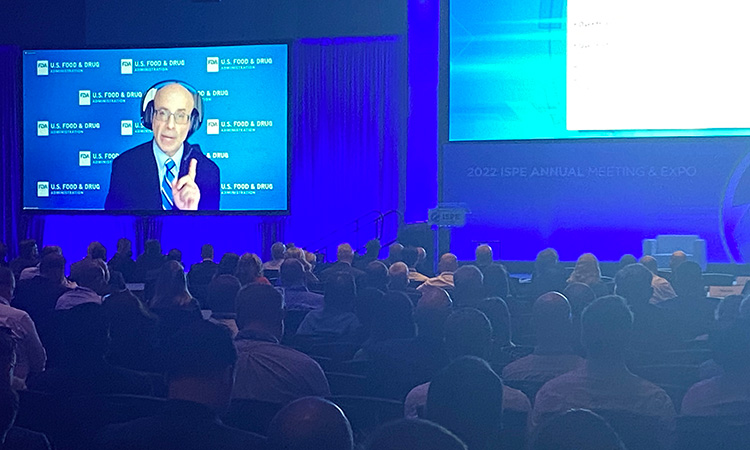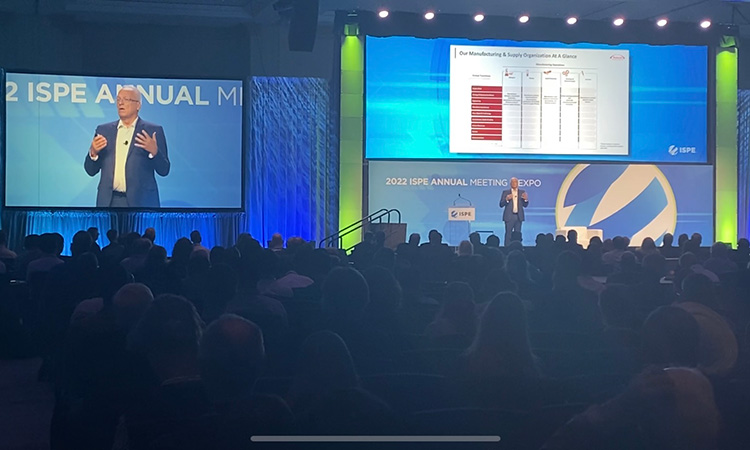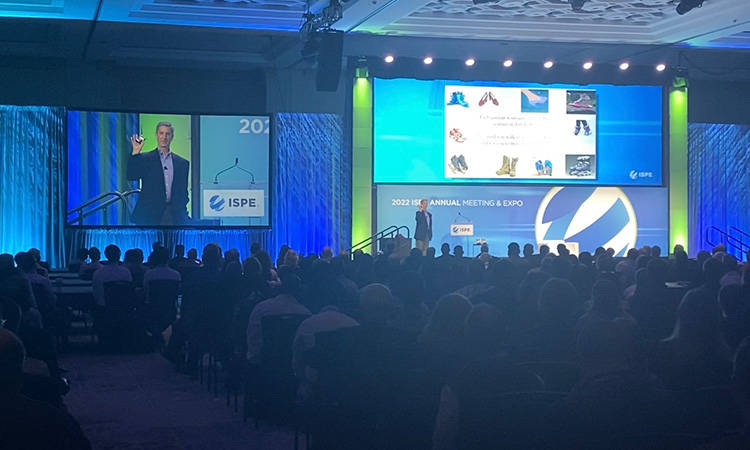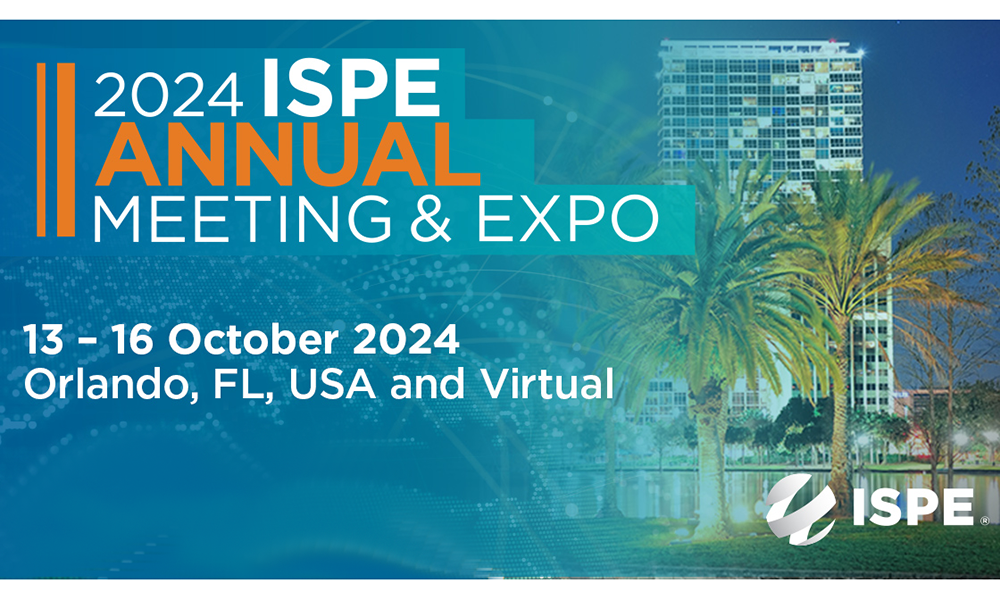2022 ISPE Annual Meeting & Expo Opening Keynotes Focus on Quality, Transformation, and Patients

The 2022 ISPE Annual Meeting & Expo opened with three keynote addresses exploring quality from a key FDA leader’s point of view, a major pharmaceutical company’s ongoing journey of transformation into an organization that is prepared to adapt to the changing world, and a unique patient perspective with a patient presenter who is also a member of the pharmaceutical community.
The opening presentations on 31 October made it clear that in-person conference attendance is back in a big way, with more than 2,000 attendees from over 30 countries and more than 200 exhibitors at the meeting in Orlando, Florida. Many of the presentations, including all keynote presentations, were also available for virtual attendees.

Thomas Hartman, President and CEO of ISPE, opened the morning session with a welcome to all attendees, pointing out the broad range of sessions, networking, and social events available for participants. He made note of the work that goes into planning the conference, thanking Robert Perks who served as this year’s Annual Meeting Conference Chair and Fran Zipp, Executive Conference Chair, as well as program committee members and the sponsors of the event and ISPE’s corporate partners.
Jörg Zimmermann, ISPE International Board Chair for 2021–2022, welcomed the attendees, noting that 2022 is seeing ISPE “back in strength” with great international conferences, local events, webinars, and a record number of comments on guidances and interactions with regulatory agencies around the world, and participation in Women in Pharma® and Pharmaceutical Engineering®, just to name a few initiatives that have seen great participation this year.
All of this energy has been channeled by the International Board into a rewriting of the ISPE Strategic Plan for 2023–25 with a “more confident position: Shaping the Future of Pharma.”

Zipp spoke next to welcome attendees, who she encouraged to make the most of the meeting through sessions and meeting with colleagues, noting that many key topics are being covered. She also noted that 17 regulators from around the world were attending the meeting.
Quality and Stability
The first keynote speaker was Michael Kopcha, PhD, RPh, Director of the Office of Pharmaceutical Quality (OPQ), Center for Drug Evaluation and Research (CDER), US FDA. He presented on “Quality: A Key Ingredient for Stable Pharmaceutical Supply Chains.”
Quality, Defined

Quality is a foundation for the development and delivery of pharmaceuticals: per Kopcha’s definition, quality means consistently meeting the expectations of the user. Patients expect safe and effective medicines with every dose, so pharmaceutical quality assures that every dose is safe and effective, free of contamination and defects. Kopcha calls this a standard definition of quality, but adds that quality is what gives patients confidence in their next dose of medicine.
Kopcha further broke out the definition of quality in the pharma industry into three types of quality:
- Quality management: gives manufacturers confidence that every batch will be acceptable to release. Performance and patient focus identifies areas of improvement and implements change.
- Process quality: gives manufacturers confidence in every batch they release. Manufacturing risks are controlled to provide a quality drug product.
- Product quality: gives patients confidence in every dose they take. Every dose is safe and effective and free of contamination and defects.
The US FDA monitors quality, and Kopcha traced changes in regulation of quality over the years. He feels that in past, quality monitoring was pedantic, reactive, and punitive, with a focus on lagging indicators of quality problems instead of on leading indicators.
That is changing and the future of quality regulation focuses on continuous improvement to foresee emergencies, reduce supply disruptions, and promote innovation; commitment to quality including thoughtfully designed quality management systems and mature quality management practices; and oversight focus that goes beyond just compliance with cGMPs, he said. Future regulation should be pragmatic, proactive, and rewarding.
FDA Activities in Support of Quality
CDER and OPQ (established in 2015) focuses on quality throughout the produce life cycle, but it faces the challenge of the global nature of the industry, he said: over three quarters of API sites are outside the US; over half of finished drug formulation sites are outside the US. Many products launch globally, and regulatory strategies must be data-driven and risk-based.
With the pandemic, there was a need for quick reaction; some examples include information in lieu of inspection (FD&C 704(a)(4)), mutual recognition agreements (European Union and United Kingdom), information from regulators via confidentiality agreements, and remote interactive evaluations (RIE).
With the volatile, uncertain, complex, and ambiguous (VUCA) environment we are in today, being flexible and proactive are required, he said.
Today’s focus is on a risk-based approach centered on patient-focused quality standards. OPQ does assessment, surveillance, research, policy, and inspections, and publishes a report each year.
He encouraged attendees to see the challenges faced during the COVID-19 pandemic as an example of how to use innovation to equip ourselves to better deal with the FUCA we are living in. Even before COVID, supply chain disruptions have been a type of contagion. We are now at a point where challenges have created opportunities: challenges spur innovation, he said.
Quality management maturity (QMM) entered the discussion on ways to address the challenges in 2019 in the FDA report, “Drug Shortages: Root Causes and Potential Solutions. ” QMM encompasses a range of actions including metrics, leadership commitment, culture, sustainable compliance, enhanced pharmaceutical quality systems, continual improvement, and risk management.
OPQ is engaged in various steps to develop QMM, including a quality rating system; activities such as stakeholder meetings and a white paper released in April on the importance of QMM and an upcoming advisory committee meeting are further steps toward that goal.
QMM rating program is necessary to ensure patients have consistent access to the drugs they need. He predicted this will become a leading indicator. Developing the program requires stakeholder engagement; he listed six “Ps” in the pharmaceutical supply chain who are stakeholders: pharmaceutical manufacturers, purchasers, pharmacies, payors, providers, and patients.
Advanced Manufacturing and Quality
Advanced manufacturing is a key component of a strategy to strengthen domestic drug manufacturing and increase the supply of quality drug products, Kopcha said. FDA supports investments in advanced manufacturing, which includes providing better quality medicines using Six Sigma; reshoring drug manufacturing facilities; speeding development of novel or patient-focused drugs; reducing quality related issues that lead to drug shortages; and improve preparedness for public health emergencies.
The FDA’s Emerging Technology Program (ETP) was established for presubmission support to applicants to support advanced manufacturing, and he noted that ETP recently had the 150th FDA-sponsored ETP meeting.
Continuous manufacturing (CM), one type of advanced manufacturing, is making an impact through faster times to approval and to get products to market, he said. CM has potential to increase flexibility and agility in response to changing demand.
Framework for Regulatory Advanced Manufacturing Evaluation (FRAME) is another FDA initiative supporting innovation with a lot of activity this year : a distributed and point-of-care discussion paper is on the Federal Register for comment; an FDA/PQRI distributed and point-of-case manufacturing workshop will take place mid-November; and an artificial intelligence discussion paper for publication in the Federal Register is planned.
International convergence is another area in which the FDA is a participant, including in initiatives related to viral safety (ICH Q5A), CM (ICH Q13), quality risk management (QRM; ICH Q9), analytical procedure development (APD; ICH Q2/14), pharmaceutical product life-cycle management (ICH Q12), and common technical document (ICH M4Q).
International convergence pilot programs include collaborative assessment of postapproval changes and hybrid inspections. The future could bring a regulatory cloud with one application for all regulators to assess in parallel; harmonized expectations for data, standards, assessments, and inspections; and a virtual repository for life-cycle management. Industry 4.0 will make its mark on quality in the future as well.
-

Michael Kopcha
-

Thomas Wozniewski
-

Robert Weker
Transforming Global Manufacturing and Supply
Thomas Wozniewski, Global Manufacturing and Supply Officer at Takeda Pharmaceutical Company Ltd, presented on “Future-proofing a Global TechOps Organization: The Transformation of Global Manufacturing and Supply at Takeda.”

Technology and new modalities are important and the transformation is about making drugs available to patients who need them, Wozniewski said. He gave an overview of Takeda’s history including recent changes that have broadened the types of drug products being produced through the acquisition of Shire that doubled the company and took it from small molecule drugs to producing large molecules and other products.
Transformation Plan
People, technology, and innovation are central to Takeda’s transformation strategy, Wozniewski said, built on a base of strong values and with a focus on
- Organizational growth, including building a diverse workforce
- New competencies, with a focus and culture embracing learning
- Financial commitment to improved productivity and transparency to quantify return on investment
- Footprint optimization aligned with the company’s changing product portfolio and patient demands
- Organizational agility, increasing this and speed in decisionmaking
To achieve these goals, Takeda created a global transformation program that initiated with a focus on people and a strong emphasis on all employees embracing learning. A recent employee survey indicated that agility of processes is an area for improvement so this is being addressed; optimizing the footprint is another goal, he said. A commitment to digital is a large part of the transformation, as is a commitment to sustainability.
Patient Viewpoint
As always, the Annual Meeting features a presentation by a patient; this year’s presentation was given by a patient who is also a member of the pharmaceutical industry. In his presentation “A Cancer Veteran’s Remarkable Journey,” Robert Weker, Principal, Weker Advisors LLC, described his experience as a three-time cancer survivor. Weker previously worked at GSK in strategy and operations in research and development.
He focused his presentation on his most recent battle with pancreatic cancer and his journey through treatment into recovery. As Weker noted, each patient is unique, and each journey is different, “but until you walk in my shoes, it is really hard for you to understand.”
Weker calls himself a three-time cancer “thriver,” having thrived through testicular, liposarcoma, and now pancreatic cancers.
“I’m really driven to help patients make an informed decision,” he said. “This means patients need to understand the options in front of me, both approved treatments and experiments. What are the benefits? Potential risks? Likelihood of recurrence?”
He reviewed early warning signs of pancreatic cancer, and urged attendees to pay attention to these and take the time to see a doctor. “My two favorite words: early detection. They gave me the opportunity to intercede and be as proactive as I could.” The numbers were not promising, Weker said: the five-year survival rate for pancreatic cancer is just 6%, and only 15% of patients with this cancer are eligible for surgery. It is a hard to detect cancer, often found very late by the time it is diagnosed; 80% of patients die within a year. He noted that pancreatic cancer is the 13th most diagnosed cancer, and the 4th deadliest, with projections by the end of the century to be the second most deadly.
Facing an especially dangerous cancer, Weker made his first major decision about whether to enter a clinical trial or not. The traditional path at the time of his diagnosis was surgery if eligible, recuperation, then chemo and radiation. The trial at that time involved high doses of vitamin D with chemotherapy, and began with chemo, then surgery, recuperation, more chemo, and finally radiation. He had input from both colleagues at work and family members in the medical industry: 80% advised against the trial, but he chose to join the trial.
His reasoning was not scientific: he felt if he had surgery first and the surgery did not remove all the cancer, remnants could spread while he was recovering from the surgery. “My view was if I do one round of chemo first, it would scorch the earth, making it hard for remnants of the tumor to spread. That’s why I opted to do the trial.”
Challenges during the treatment were many: pain management was one since he needed to wean off pain medication after surgery before chemo could start. Getting sufficient enzyme intake has been an ongoing issue with trial and error and adjustments that continue. Although Weker did not experience nausea from chemo, he did suffer from other side effects such as neuropathy and soft nails.
Being an advocate for himself was another challenge: he shared that his oncologist wanted to use an infusion pump for chemo due to very specific dosing requirements and most patients found the pump very manageable. When he learned that most patients were much older than he was at the time of treatment, he was able to make the case that he would be able to follow the dosing regimen of an oral pill instead of an infusion pump, and his doctor agreed.
Dealing with insurance, especially to obtain coverage for the proton beam radiation that was part of the treatment, was another opportunity to be an advocate for himself. The insurance company saw it as experimental and did not want to pay; fortunately, Weker said, his employer’s appeals process worked after four appeals to obtain coverage.
Another challenge was what Weker called the psychosocial burden: he was unsure about whether he would live or what life would be like.
Weker wanted and needed to work through treatment in addition to focusing on recovering. His employer’s HR department recommended short-term disability, but that would have meant not being able to work. So he tailored his work-leave plan, using saved personal time for surgery. “I needed to work; if they took that away from me, I don’t know what I would have done.”
He faced post-treatment challenges as well. “Scanxiety” was the fear about the scans every three months for the first few years to “see how things are going,” he said. “The amount of anxiety about going in, having the scan, and waiting for results is hell. That’s a real thing.”
Weker also had to deal with related medical events including internal bleeding that led to 11 emergency room visits in 9 months and ultimately GI anastomosis surgery. He also endured malnutrition, paracentesis, and had a shunt placed in his liver and a stent in a vein between his liver and bowels.
Now Weker lives with a “new normal” that includes what he calls “settle time” in the mornings, when he walks to try to settle to see what type of day it will be. He has ongoing gastrointestinal and diet issues, and medication fluidity including about 20 pills a day. “That’s my normal, and what I’ve got to do. I am not what I was. I don’t necessarily want to explain it to people all the time.”
He summarized his key learnings as a patient:
- Be an active partner with medical team, and ask questions.
- Do your homework.
- Be honest with doctors, colleagues, friends, and family.
- Try to make informed decisions: ask lots of questions and make sure you understand.
- Seek support: experienced patients are a good source.
- Know thyself. Be true to yourself.
“I am incredibly thankful to you guys for what you do and how you help us,” Weker told attendees. “It is important. Patients are waiting.”
Finally, he said, “Being a patient is hard. Being a caregiver is much harder.”
Disclaimer: This article contains an abridged, unofficial summary of an FDA regulator’s presentation at a conference that has not been vetted by the agency. The content represents an informal and brief synopsis of the regulator’s views, and does not represent official guidance or policy of the FDA.





